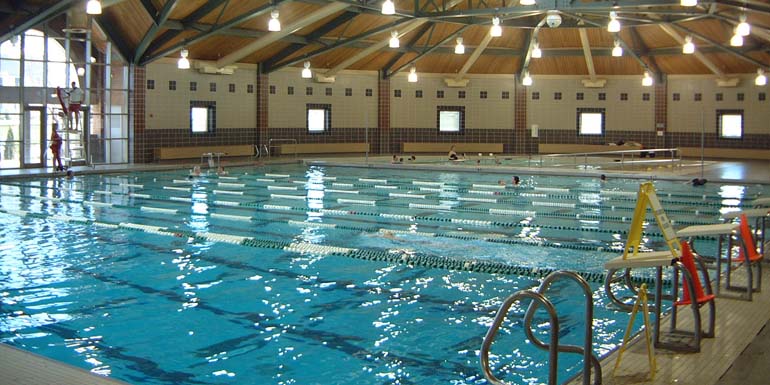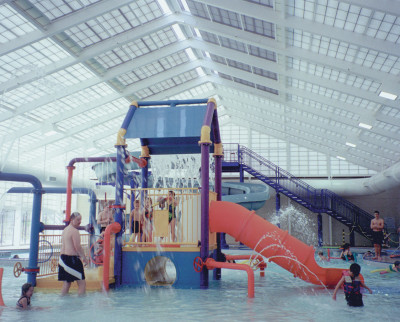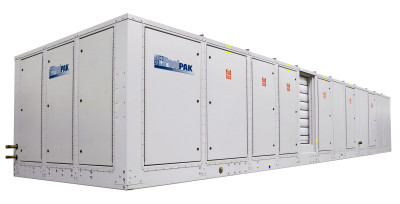Dehumidification technology
by Sally Bouorm | October 1, 2010 3:25 pm
 [1]
[1]By Chris Soh
Sesame Street’s Kermit the Frog may have had a point when he sang, ‘It’s not easy being green.’ In the past, this may have also been true for indoor pools, as designers, developers and managers wrestled with how to cost-effectively operate and maintain comfortable indoor conditions for patrons in various outdoor climates. Today, however, it has become easier to maintain indoor conditions with improvements in structural design, equipment and advanced operating techniques.
‘Green,’ with regards to indoor pools, may have many different shades. For example, it can come in the form of saving power through energy recycling, or using dehumidification equipment that operates efficiently under all conditions.
Select the right equipment and location
Selecting dehumidification equipment is probably one of the most critical decisions in the development of an efficient indoor pool facility. When evaluating the different products available, compare the components each system uses. Keep in mind, only dehumidifiers designed for indoor pool environments should be considered. Standard air handlers work well in heating, ventilating, and air conditioning (HVAC) applications, but can quickly deteriorate in a corrosive pool environment. For example, installing a standard dehumidification unit with a 15-year rated lifespan under non-pool environment conditions can self-destruct in only a few years of pool operation.
The facility’s geographic location should also be considered when selecting equipment.
For facilities in cold, dry areas, heating will be required a majority of the time. As such, a system that uses air-to-air heat recovery will reduce heating needs by capturing energy in the ventilation air stream. Recycling this heat energy is critical to savings.
Heat recovery systems, such as heat pipes or plate-type heat exchangers, recover waste heat from the exhaust air stream and return it into the outside air stream. Ventilation-based dehumidification units maintain reasonably good summer conditions, but are not as accurate as mechanical dehumidification equipment. Using non-refrigerant-based ventilation equipment can also save energy. These systems take advantage of the outdoor air being drier than the air in the pool room and utilize it for humidity control.
In hot, moist environments, mechanical dehumidification equipment is almost always required to maintain low relative humidity levels and cool the pool room during the summer. In this case, it is important to have a unit with an efficient refrigeration system, which allows compressor cycling and air-mixing control.
In areas with long-hot seasons and low humidity, either dehumidification through ventilation or mechanical dehumidification can be used. Cooling can be maintained using chilled water (ventilation-type) or refrigeration (mechanical dehumidification) during peak heat times. As the temperature decreases, compressors can be shut down to save energy while maintaining the desired relative humidity level.
It is all about efficiency
In the past few years, some manufacturers have increased equipment efficiency by nearly 16 per cent, with efficiency measured as the moisture removal capacity per compressor kW input.
That said, there is efficient and then there is exceptionally efficient dehumidification equipment. The difference—some units may have low-energy-consuming components, while others also include operational strategies, which help further reduce energy consumption and costs.
 [2]
[2]First and foremost, a mechanical dehumidification system must have the ability to recycle energy removed during the dehumidification process back to the pool water and air. A majority of indoor pools, regardless of their geographic location, require heating 70 to 90 per cent of the year. Selecting a system with a high-thermal coefficient of performance (COP) can satisfy dehumidification and heating, while almost eliminating fossil fuels for auxiliary heaters.
All new refrigerant-based equipment must now use R-134a and/or R-410A; the former is a high-temperature refrigerant, while the latter is used as a refrigerant in air conditioning applications and produces more cooling and dehumidifying capacity per kW. Both do not contribute to ozone depletion and are becoming more widely used. Older systems using R-22 refrigerant cannot be upgraded.
Large dehumidification equipment used for commercial operation and natatoriums must have ample cooling capacity to deliver moisture control and seasonal cooling. Efficient refrigeration systems operate using multiple compressors and allow multi-stage modulation to manage the electrical load. This feature yields maximum system efficiency and lifespan, while assuring the best quality indoor air and pool water conditions at the lowest cost.
 [3]
[3]All dehumidification systems require blowers to circulate conditioned air and ventilation throughout the facility; however, not all blower motors are built alike, with some being expensive to operate. Equipment built to National Electrical Manufacturers Association’s (NEMA’s) standards for totally enclosed, fan-cooled (TEFC) motors are quite efficient, as they require less energy for equal loads and have a longer service life. Even the fan’s design can affect efficiency. For example, backward inclined airfoil-type fans (BIAF) move air more effectively, which also results in reduced energy requirements.
It is a little known fact that a properly operating dehumidification system can, in one year, remove an entire swimming pool worth of water from the air. As such, look for systems that can recycle extracted water back into the pool, thus saving the facility costs on water consumption.
Built for the pool environment
The discussion about dehumidification systems for indoor pool facilities would not be complete without touching on the equipment’s fabrication. The indoor pool environment is highly corrosive, as chloramine off-gassing attacks all metallic surfaces, causing corrosion. However, the use of high-performance coatings and copper parts and components help ensure the long equipment life. This, in turn, reduces the environmental impact caused by disposal.
Some manufacturers also powder coat the equipment’s sheet metal sections to meet or exceed U.S. and European standards for minimum volatile organic compounds (VOC) air pollution emissions. The coating process is an environmentally friendly commercial painting technology that protects sheet metal against the corrosive effects of highly concentrated chemical- and humidity-laden air. Critical components such as compressors should not be located in the corrosive air stream (the path through the dehumidification system where the facility’s supply and return of conditioned air travels, which more than likely contains chloramines), as this decreases life expectancy, reliability and uses more natural resources. Items like compressors, electrical components and actuators will eventually reduce in efficiency or fail prematurely. A dehumidification unit is not designed to remove chloramines, this must be controlled through proper water chemistry management.
Control strategies make the difference
Dehumidification equipment manufacturers have made great strides in improving operation by using high-efficiency components. When combined with a sophisticated control system, however, additional advantages can be earned.
Occupied/unoccupied mode
Although commercial swimming pools are rarely occupied 24 hours a day, dehumidification is still required to maintain indoor air quality. At the same time, however, ventilation requirements are not necessary. If the equipment’s control system includes an ‘occupied/unoccupied’ mode, the pool’s outside and exhaust air fans can be turned off to further reduce energy costs.
Condensate prevention system
To the untrained eye, condensation formation may seem more like an esthetic problem for an aquatic facility; in fact, it can lead to structural component deterioration and inefficient use of energy and equipment. A wall condensate prevention system, however, will constantly monitor outdoor climate conditions via a sensor on the coldest inside wall. As the outside temperature lowers (along with the wall temperature), a smart control system will lower the space dew point as needed. This prevents condensation on the cold surface, unnecessary over-sizing of the dehumidifier and excessive compressor operation.
Economizer operation
Depending on the facility’s geographic location and the low percentage of times cooling is required, waste heat removal is still necessary. By utilizing an indoor pool’s huge thermal mass (ability to store heat), a well-engineered dehumidification system can redirect waste heat to the pool with little affect on water temperature, thus eliminating the need for an external condenser. Energy savings are achieved by minimizing compressor and eliminating condenser motor operation, which in turn reduces impact on resources.
In addition to traditional economizer operation, a variation called the ‘smart economizer’ supplements water and space heating using outside air. As hot, moist air travels over the evaporation coil to cool and dehumidify, the smart control system compares it to outside conditions. If the outside air is warmer and dryer than the conditioned air, it is used and the conditioned air is exhausted. This system will add another 15 to 20 per cent in energy savings over dehumidifiers without an economizer.
Passive air-side heat recovery system
Ventilation is mandated in all commercial buildings, and indoor pools are no exception. However, ventilation becomes more costly in colder climates where make-up air must be heated to maintain desired space conditions. By installing a passive, air-side heat recovery system, heat energy that is normally exhausted during space ventilation can be captured to preheat incoming air, thus saving considerably on fossil fuel requirements.
Carbon dioxide (CO2) demand-based ventilation
Another way to reduce ventilation requirements, especially during swim meets or limited occupancy, is through CO2 demand-based ventilation. Many dehumidification systems have a preset ventilation volume based on average occupancy. Controllers equipped to monitor CO2 levels, however, can adjust ventilation needs to meet the occupancy requirements while not over ventilating. By reducing heating and cooling loads, overall operating costs can be reduced quite significantly.
‘Smart’ pool water pump control
The same theory applies to the dehumidification unit’s pool water pumping system, which is separate from the pool’s circulation system. Most dehumidification systems are designed to heat either the air or water using energy recovered through the dehumidification process. By using a ‘smart’ pool water pump control as part of the control system, the unit’s pump is turned off when the system is in air priority mode. Using this device as little as 50 per cent of the time can save a facility up to $3,000 per year.
Building design also affects efficiency
There are many ways to efficiently operate an aquatic facility based on the dehumidification equipment chosen and its features. However, even the best equipment will perform poorly if the facility is designed incorrectly and/or has inadequate air distribution.
Basic building design considerations should include protection against air migration. Vapour barriers should be installed immediately behind the interior wall surface to prevent moisture within the pool room from migrating into the wall, where it will quickly reach dew point due to the colder air temperature. If vapour barriers are not installed or installed incorrectly, the dew point will be reached within the wall and the moisture will impregnate the insulation, decreasing its R-value (efficiency).
Thermal performance doors and windows, which limit heat migration and condensation formation, are also important to the facility’s design. For instance, glass doors and windows exposed to outside air should use double- and triple-glass panels and be insulated or sealed in metal or vinyl clad frames. Window frames must have thermal breaks, be sealed to adjacent walls and insulated with a non-porous insulating material.
Pool facilities with open sunlit atriums and windowed walls are candidates for high cooling loads. Increasing ventilation rates during peak periods or simply opening doors and windows can offset this greenhouse effect.
Water attractions such as slides, fountains and water cannons have gained popularity, but higher costs are associated with their operation due to an increase in water evaporation rate. Thus, dehumidification systems must work harder and longer to maintain a desired 50 to 60 per cent relative humidity within the facility.
Surface areas that collect water from the pool also create an additional load on dehumidification equipment. Avoid the use of absorbent deck coverings (e.g. carpet) within the pool area, and limit wet deck areas by installing adequate drainage and/or reducing deck over spray.
Proper airflow maintains comfort, reduces cost
Efficient dehumidification will take place if the air distribution system is designed properly. The air distribution system’s purpose within an aquatic facility is to maximize air flow by keeping warm, dry, supply air over any surface prone to condensing temperatures, including all walls, windows and skylights.
Careful consideration must be given to supply air ducts and air return grill locations. Supply air should be directed at the walls (80 per cent) and along the ceiling (20 per cent) to break up any stratification and stagnation occurring near the ceiling. Using a wall washing technique will also reduce the possibility of cool, dead air spaces forming around windows or walls and migrating to the pool edge. For example, ceiling ducts should be positioned near windows and close enough to sufficiently wash the cold glass with an even blanket of air. The supply air should be ducted below grade around the enclosure’s inside perimeter using linear slot diffusers for low set windows and sliding glass doors. Returns must be positioned so all moist, warm air flows efficiently back to the dehumidification system, eliminating dead areas where air stagnation can occur.
Although typical return heights are located 3 to 4.5 m (10 to 15 ft) above the floor to capture rising warm, moist air, recent studies show positioning returns closer to the pool water surface lightly draws off the chloramine air layer that may settle over the pool’s surface. This technique also draws away moist air while not affecting the evaporation rate or creating uncomfortable air currents.
Ducts should never be positioned in a way that will result in supply air short cycling (recycle prematurely). This can happen when the return duct’s location is too close to, or directly in line with the supply duct.
Maintaining a slight 1.2 to 3.8-mm (0.05 to 0.15-in.) negative water pressure in the pool area, relative to surrounding spaces, will help prevent moisture and chlorine odours from being pushed into other areas of the aquatic facility.
Conclusion
Whether replacing an existing air quality control system or designing a new pool facility, it is important to know a comfortable bathing environment can be achieved without draining the bank through high operating costs. Today’s high-efficiency dehumidification equipment provides benefits for both the facility and the environment. Keep in mind, however, not all equipment is designed and built the same. When dealing with the unique environment of an aquatic facility, be sure to choose a manufacturer with experience in this area to ensure the equipment will offer uninterrupted operation for many years.
 Chris Soh is the product manager for Poolpak Technologies Corp., a manufacturer of dehumidification equipment for aquatic facilities in York, Pa. Soh has a bachelor degree in electrical engineering from University of Kentucky. He can be reached via e-mail at sales@poolpak.com[4].
Chris Soh is the product manager for Poolpak Technologies Corp., a manufacturer of dehumidification equipment for aquatic facilities in York, Pa. Soh has a bachelor degree in electrical engineering from University of Kentucky. He can be reached via e-mail at sales@poolpak.com[4].
- [Image]: http://poolspamarketing.com/wp-content/uploads/2010/10/pool_shot2.jpg
- [Image]: http://www.poolspas.ca/wp-content/uploads/2015/07/waterpark.jpg
- [Image]: http://www.poolspas.ca/wp-content/uploads/2015/07/PPK_SR.jpg
- sales@poolpak.com: mailto:sales@poolpak.com
Source URL: https://www.poolspamarketing.com/trade/dehumidification-technology/